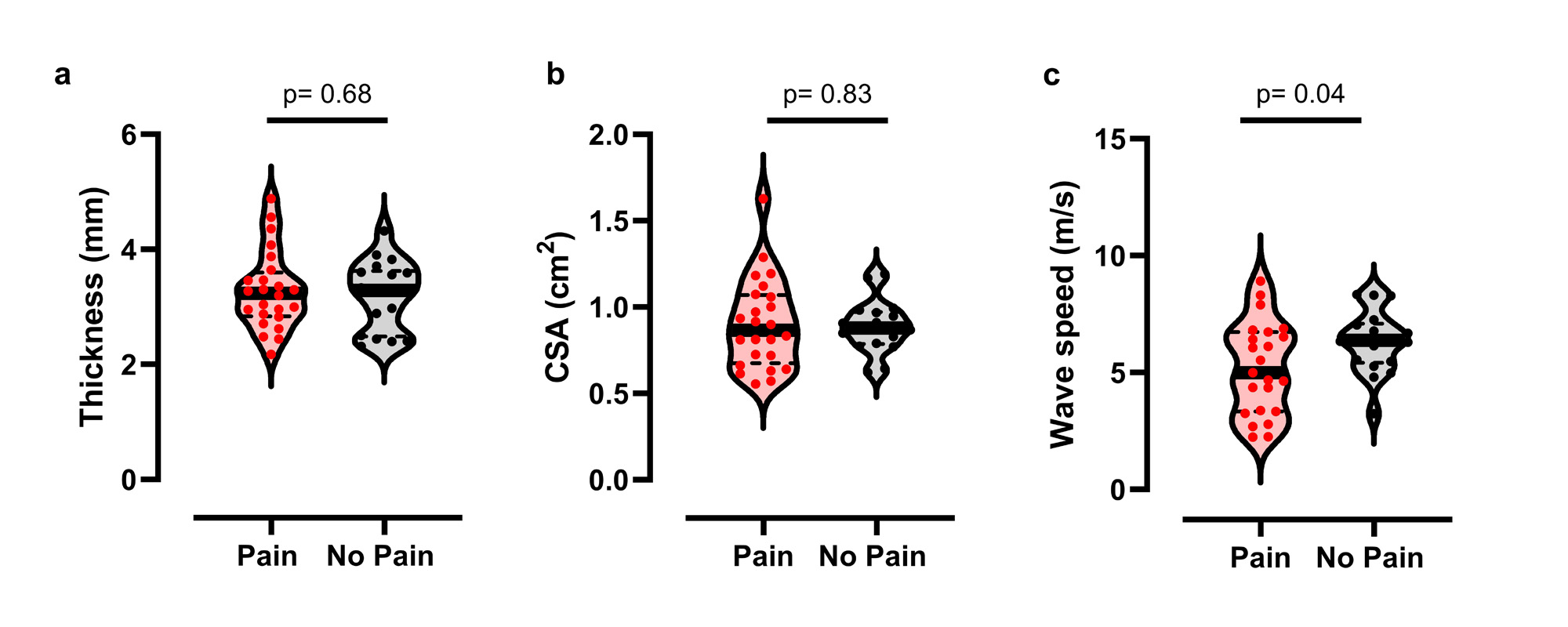Session Information
Session Type: Abstract Session
Session Time: 4:00PM-5:30PM
Background/Purpose: Knee pain is one of the most common types of joint pain leading to disability, limited physical activity, and reduced quality of life. While numerous risk factors for knee pain have been identified, extensor tendons have received limited attention. Altered patellar tendon structure and stiffness may contribute to knee pain through their effects on quadriceps muscle function and joint biomechanics. In this study, we aimed to determine if patellar tendon characteristics differed between adults with and without knee pain.
Methods: Adults over the age of 45 with and without knee pain were recruited. Exclusion criteria included: history of traumatic knee joint injury in the past 6 months, knee joint injection in the past 3 months, knee replacement, or a diagnosis of rheumatoid arthritis, ankylosing spondylitis, psoriatic arthritis, reactive arthritis, lupus, gout, bone cancer, connective tissue disorders, or neurologic condition.
Patellar tendon characteristics were assessed bilaterally with a GE LOGIQ e10 ultrasound scanner immediately distal to the proximal enthesis. Participants were resting in a seated position with their hips and knees flexed to 90 degrees. Brightness mode was used to assess patellar tendon thickness and cross-sectional area (CSA). Shear wave elastography was performed to estimate patellar tendon shear wave speed, a surrogate measure of tendon stiffness. For each measure, three trials were acquired and averaged.
For analysis, we compared the most symptomatic limb in those with knee pain to a randomly selected limb in those without knee pain. The most symptomatic limb was defined as the limb with the highest VAS pain score (0-100). If VAS scores were identical, the Western Ontario and McMaster Universities Osteoarthritis Index (WOMAC) pain subscale was used to define the index knee. Patellar tendon thickness, CSA, and shear wave speeds were compared between groups using independent t-tests.
Results: A total of 42 adults were included, 24 with knee pain (VAS pain ≥1) and 18 without knee pain (VAS=0). Individuals with knee pain (14 female) had a mean (SD) age and BMI of 61 (10) years and 32.23 (5.28) kg/m2, respectively. Individuals without knee pain (10 female) had a mean (SD) age and BMI of 63 (10) years and 30.95 (6.15) kg/m2, respectively.
Mean (SD) patellar tendon thickness, CSA, and shear wave speeds for the entire sample were 3.25 (0.64) mm, 0.90 (0.22) cm2, and 5.68 (1.79) m/s, respectively. Patellar tendon shear wave speeds were significantly slower in knees with pain compared to knees without pain (Figure 1). Patellar tendon thickness and CSA were not significantly different between groups (Figure 1).
Conclusion: Compared to knees without pain, those with knee pain have reduced patellar tendon stiffness. Further work in this area is needed to determine if treatments that target the patellar tendon are effective at reducing knee pain.
To cite this abstract in AMA style:
Price S, Silbernagel K, Felson D, Stefanik J, Corrigan P. Comparing Patellar Tendon Characteristics Between Adults with and Without Knee Pain [abstract]. Arthritis Rheumatol. 2023; 75 (suppl 9). https://acrabstracts.org/abstract/comparing-patellar-tendon-characteristics-between-adults-with-and-without-knee-pain/. Accessed .« Back to ACR Convergence 2023
ACR Meeting Abstracts - https://acrabstracts.org/abstract/comparing-patellar-tendon-characteristics-between-adults-with-and-without-knee-pain/

